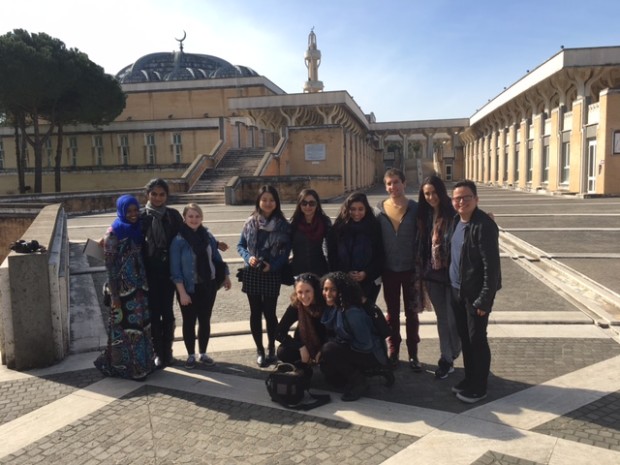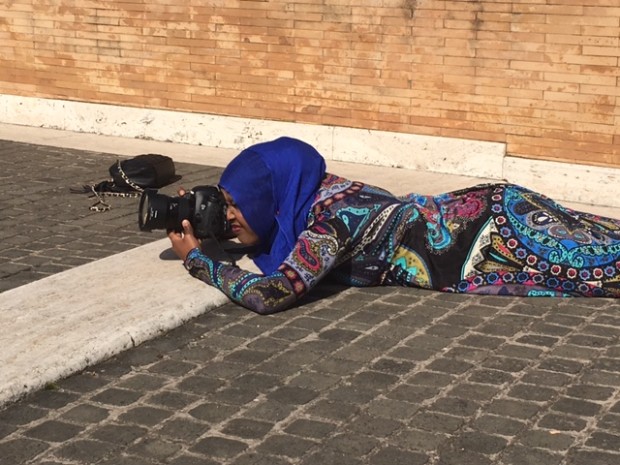
Religio16 stands outside the Great Mosque. March 12, 2016 in Rome, Italy. (Religio / Daniel Rodriguez)
Religio16 touched down in Rome Saturday morning after an eight-hour flight from New York. We hopped on a bus that took us to our hotel, which is just outside the walls of the Vatican, and then headed off on our first day of religious exploration.
In the course of the day, we visited the largest mosque in Europe, four churches (three of them with Caravaggios) and ended up in the old Jewish ghetto, where we dined on fried artichokes and other local delicacies.
We began the day by taking several white cabs to the Moschea di Roma, or Great Mosque of Rome. The mosque, located about four-and-a-half miles north of our hotel, is the largest in Europe. The facility is spacious with a large outdoor garden and beautiful, elaborate architecture. Omar Camilletti, a member of the mosque’s Governing Council, greeted our class and gave us a history of the place of worship. When asked about some of the challenges the mosque faces, Camilletti responded by saying Islam is not officially recognized by the Italian government, and many in the community wish the religion received the official status.

Fahmo Mohammed takes a photo of the architecture at the Great Mosque. March 12, 2016 in Rome, Italy. (Religio / Daniel Rodriguez)
Upon returning from the Great Mosque, our class was given an exceptional walking tour of Rome by our very own Professor Alexander Stille. Although we are in our twenties and Professor Stille is a bit older, we had a hard time keeping up with him.
“I love Rome, it gives me energy each time I visit and return here,” he explained. We covered over five miles negotiating our way through crowded Roman streets.
We visited St. Peter’s Square and four churches including one where the trail of Galileo was held in the 17th Century. Other sites included the Pantheon and the Trevi Fountain, where several students made positive intentions and prayers before throwing a coin into the Baroque fountain. Professor Stille seems to have an obsession with Caravaggio, the 16th Century painter, and knows all the churches where his work can be found.
For many of the students on the reporting trip, this is their first time visiting Rome and Europe. This is the first time Armando García has left the United States since he moved to the country from Mexico as a small child.
“For me it has been a lifelong dream to leave the country and see something outside of the U.S.,” he said. “As soon as I stepped off the plane, I felt as though I stepped back in time. And it’s the first time I actually felt connected to history.”
Lora Moftah has visited Rome before, but this experience has given her a different perspective of the city.
“I am now able to see the city with new eyes through the lens of religion,” Moftah said. “Obviously Rome is a very religious city, but to see where Catholicism intersected with other faiths including Judaism and Islam, these are all sides I had never seen before.”
What are the prospects for Islam getting officially recognized?